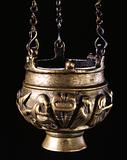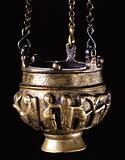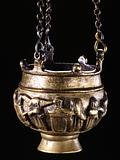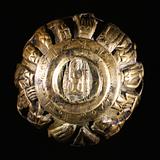Incense burner, cast and engraved bronze, later chain
Syria or Palestine; 8th-9th century
H: 11; Diam: c. 10 cm
In the first centuries after the hijra, the Muslims conquered extensive territories inhabited by Jews and Christians. They were largely allowed to live in peace and to keep and practice their religions as long as they paid poll taxes to the Muslim authorities.
The Christian incense burner – with quite primitive depictions in relief of the Annunciation, Christ’s birth and baptism, the Crucifixion, and the tomb of Christ – belongs to a group that is normally ascribed to the Syrian and Palestinian area. This attribution is further confirmed by the unique inscription in early Kufi that can be translated as follows: “In the name of Allah (God), made by Yaqub, son of Ishaq from Damascus.”
The virgin Mary with Jesus, around them the unique inscription in early Kufi
Inv. no. 7/1994
Published in:
Kjeld von Folsach, Torben Lundbæk and Peder Mortensen (eds.): Sultan, Shah and Great Mughal: the history and culture of the Islamic world, The National Museum, Copenhagen 1996, cat. 33;
Kjeld von Folsach: Art from the World of Islam in The David Collection, Copenhagen 2001, cat. 454;
Joachim Meyer: Sensual Delights: Incense Burners and Rosewater Sprinklers from the World of Islam, The David Collection, Copenhagen 2015, cat. 1;
Elizabeth C. Kelly: Zoomorphic incense burners of Medieval Khurasan: a study of Islamic metalwork, Oxford 2024, fig. 8.6C;
Joachim Meyer, Rasmus Bech Olsen and Peter Wandel: Beyond words: calligraphy from the World of Islam, The David Collection, Copenhagen 2024, fig. 51, pp. 78-79;




